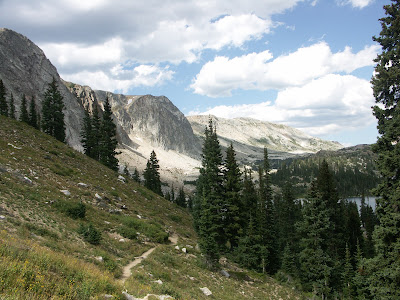 |
| White-tailed Ptarmigan (male) Rocky Mountain National Park, Laramier County, CO (June 2013) |
The White-tailed Ptarmigan has the most southerly distribution of any of the ptarmigan in North America (Rock Ptarmigan gets at least as far south in Japan), with their native range reaching as far south as the mountains of northern New Mexico. Found in alpine habitats at or above treeline, White-tailed Ptarmigan can be found in areas with stunted willows, sedge meadows, and other alpine habtiats (Braun et al. 1993) They are widely distributed across alpine tundra habitat in Colorado, and are also found in southwestern Montana and the Cascades of Washington. Ptarmigan have also been introduced into mountains in northern Utah, the Sierra Nevada in California, and the Wallowa Mountains in Oregon. However, despite this extensive range throughout the Rocky Mountains, White-tailed Ptarmigan are strangely absent from Wyoming. A range map shows a large gap in their distribution in Wyoming. Why is this the case? Have they always been absent?
 |
| White-tailed Ptarmigan (male) |
 |
| White-tailed Ptarmigan (female) Rocky Mountain National Park, Larimer County, CO (June 2013) |
A bit of research into the history of this species reveals that White-tailed Ptarmigan used to be found in the Snowy Range, just outside of Laramie. Regular reports of the species go back as far as the mid-1970's, with a single documented record from 2005 which may represent a dispersal event from Colorado (Hoffman 2006, Faulkner 2010, Cornell Lab of Ornithology 2012). Anecdotal sight evidence from the Wind River Range and the Bighorns have been presented from the 1930's, but this is unverified, and subsequent searches of these areas have found no evidence of ptarmigan anywhere else in the state, despite extensive suitable habitat (Hoffman 2006).
 |
| View of the alpine zone in the Snowy Range |
So, if White-tailed Ptarmigan were in the Snowy Range as recently as the mid-1970's, why are they no longer there? A report prepared by Hoffman (2006) for the USDA Forest Service suggests several reasons for their absence. First, the available habitat is very limited, and may be unable to support a sustainable population. While there may be immigration from Colorado occasionally (as the 2005 record suggests), they are unlikely to persist. Second, the area has high recreational usage, both from extensive snowmobiling in the winter, and hiking in the summer, which may degrade habitat. Finally, the alpine tundra habitat was extesnsively grazed by sheep until 1997, which may have also degraded the habitat to a point that it is unable to sustain a population of ptarmigan (Hoffman 2006).
 |
| White-tailed Ptarmigan (male) Rocky Mountain National Park, Laramier County, CO (June 2013) |
Despite there being sustainable populations of ptarmigan only 50 kilometers from the Snowy Range, and less than 10 kilometers from the Wyoming border, it is unlikely that White-tailed Ptarmigan will again have a sustained population in southeast Wyoming due to continued habitat degradation. Why ptarmigan have never been conclusively found in the other Wyoming ranges, however, remains a mystery. Until we learn more, we will have to be content with hopping across to Colorado and enjoying this spectacular grouse there.
Note: all photos in this post are © Shawn Billerman
References:
Note: all photos in this post are © Shawn Billerman
References:
Braun, CE, K Martin, and LA Robb (1993) White-tailed Ptarmigan (Lagopus leucura). The Birds of North America Online (A. Poole, Ed.). Ithaca: Cornell Lab of Ornithology; Retrieved from the Birds of North America Online: http://bna.birds.cornell.edu/bna/species/068
Cornell Lab of Ornithology (2012) eBird. Avian Knowledge Network. Ithaca, NY. www.avianknowledge.net
Faulkner, D (2010) Birds of Wyoming. Roberts and Company Publishers, Greenwood Village, Colorado
Hoffman, RW (2006) White-tailed Ptarmigan (Lagopus leucurus): a technical conservation assessment [Online]. USDA Forest Service, Rocky Mountain Region. Available http://www.fs.fed.us/r2/projects/scp/assessments/whitetailedptarmigan.pdf


